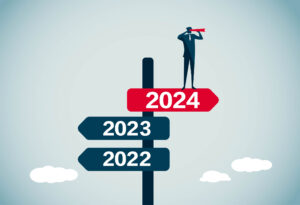
2024: More AI use & EV acceptance, focus on shop administrative shortage
By onBusiness Practices | Market Trends
Big changes are predicted for the year ahead, in both sales and repair, according to CCC Intelligent Solutions and Cox Automotive.
In addition to the ongoing technician shortage, CCC predicts a shortage of administrative personnel this year.
“In 2024, shops are likely to intensify their efforts to attract and retain both skilled technicians and administrative staff,” CCC wrote on its blog. “From offering competitive wages and benefits to investing in comprehensive training programs, the industry is set to prioritize talent acquisition and development.”
In addition, the number of shop and education program collaborations may increase to facilitate hiring.
The use of artificial intelligence (AI) in shops to carry out initial damage inspections is predicted to increase this year as a means to save time, but also on administrative tasks. From appointment scheduling and inventory management to customer communications, AI can be used on the front end to give administrative staff more time to focus on complex and strategic aspects of their roles, CCC wrote.
But AI shouldn’t be left completely in charge of tasks, CCC notes. “AI is best when combined with human intelligence, empowering shop employees to work more efficiently and effectively. The collision repair industry is poised to embrace AI not as a threat but as a strategic ally in the pursuit of excellence.”
An often hot topic, consolidation and M&A, will increase this year as well, feeding off the challenges of smaller independent shops.
Specifically, mid-tier multi-shop operators (MSOs) stand to benefit from the challenges of increased competition, rising operational costs, and the need for advanced technology.
“To remain competitive, independents will need to focus on creating extraordinary customer experiences, from speed-to-respond to highly personalized services,” CCC wrote. “In 2024, we can expect to see further consolidation within the industry with the rise of mid-tier MSOs, allowing them to centralize administrative functions, share resources, and implement standardized processes across multiple locations…
“Shops that embrace innovation, invest in talent, and foster collaboration will be best positioned for growth and success in the future.”
The latest trends report from CCC looked back on 2023 and found three trends have continued, which need to be improved upon in the new year through both shops and carriers exploring “new ways of operating and delivering on customer expectations.”
Repair costs, the weekslong United Auto Workers (UAW) strike, and a rise in auto thefts took their toll on both industries over the past year, according to the report.
Vehicle sales and market changes
The year ahead, according to Cox Automotive, will play out in five themes: slow growth, increasing vehicle supply, transitioning away from a seller’s market, expanding electric vehicle (EV) market, and car buying returning to normal.
Continued high interest rates and elevated, but declining, inflation will limit consumer spending and slow job and income growth. However, Cox Automotive banks on an economy this year that will avoid a recession and move forward with slow, constrained growth.
“The labor market — a key driver of vehicle sales in the U.S. market — is expected to weaken, but unemployment levels will remain low enough to support a healthy auto industry. Wage growth will cool in 2024 but will remain above average… Overall, we are expecting consumer debt to slowly grow in 2024 and credit conditions to remain tight, but stable.”
The combined inventory of new and used vehicles is predicted to increase, up substantially from the height of the shortage in 2022, with more incentives and discounts offered. New vehicle inventory could reach pre-pandemic normal levels, reaching nearly 3 million by the end of the year, according to Cox.
“However, affordability will limit the market in 2024 and will remain an industry-wide challenge that holds new-vehicle sales well below historic highs seen between 2016 and 2018, when the market was artificially inflated by large discounts and incentives and near-zero auto loan rates,” Cox wrote. “The used-vehicle market will see gains in 2024, but gains will be minimal — less than 1%.”
Dealers will likely face falling profitability this year as “higher material and labor costs, along with more costly technology and a focus on wealthier buyers” cause MSRPs and the invoice prices dealers pay to increase, “resulting in ever more expensive products.” That, paired with increased discounting on a larger supply bringing consumer purchase prices down will cut into dealers’ margins, Cox predicts.
The EV market is predicted to continue to build this year with “more models, more incentives, more discounting, more advertising and more sales muscle.”
“In 2024, the Cox Automotive team is expecting that the industry will fully come to terms with the fact that the average consumer has to be sold on the merits of going electric, and many won’t be easily convinced,” Cox wrote. “We still believe more sales will follow, with EV sales in the U.S. in 2024 topping the more than 1-million-unit record set in 2023 and accounting for more than 10% of total sales. Hybrid models will add further to [the] mix, pushing the share of electrified vehicles — EVs, plug-in hybrids, and hybrids — to nearly 24% of the market in 2024.”
EV leases are expected to grow 5 percentage points this year, up to 25%.
Overall, 2024 will be a year of normal, Cox says.
“After four years of anything but normal, Cox Automotive is expecting balance to return to the U.S. auto market in 2024. And that will clearly be better for American consumers and fleet buyers who find more choices, better deals, and better access to online buying tools. In fact, in many ways, we are expecting 2024 to be the best year for car buyers since the pandemic.”
Images
Featured image: erhui1979/iStock
More information
OEMs, analysts share expected automotive trends that will shape 2024
